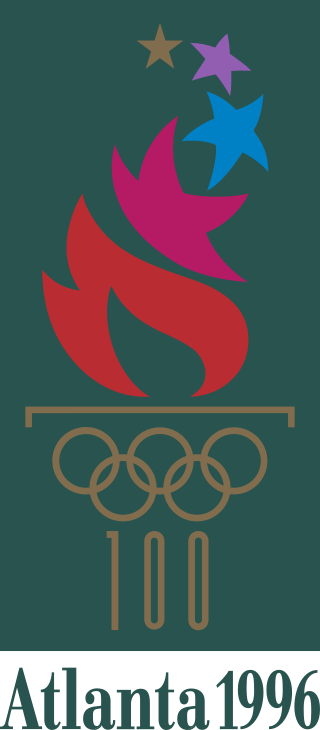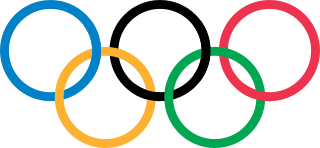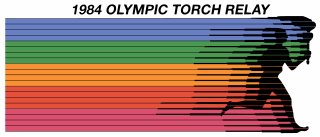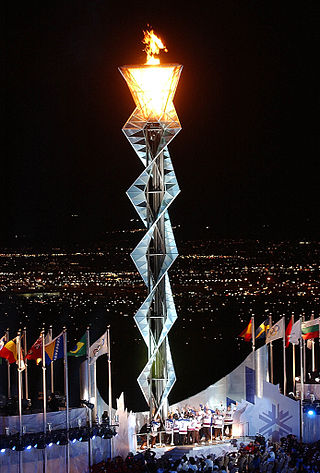
The 1996 Summer Olympics were an international multi-sport event held from July 19 to August 4, 1996, in Atlanta, Georgia, United States. These were the fourth Summer Olympics to be hosted by the United States, and marked the 100th anniversary of the 1896 Summer Olympics in Athens, the inaugural edition of the modern Olympic Games. These were also the first Summer Olympics to be held in a different year than the Winter Olympics since the Winter Olympics commenced in 1924, as part of a new IOC practice implemented in 1994 to hold the Summer and Winter Games in alternating, even-numbered years. The 1996 Games were the first of the two consecutive Summer Olympics to be held in a predominantly English-speaking country, preceding the 2000 Summer Olympics in Sydney, Australia. These were also the last Summer Olympics to be held in North America until 2028, when Los Angeles will host the games for the third time.

The 1984 Summer Olympics were an international multi-sport event held from July 28 to August 12, 1984, in Los Angeles, California, United States. It marked the second time that Los Angeles had hosted the Games, the first being in 1932. California was the home state of the incumbent U.S. President Ronald Reagan, who officially opened the Games. These were the first Summer Olympic Games under the IOC presidency of Juan Antonio Samaranch.

The Los Angeles Memorial Coliseum is a multi-purpose stadium in the Exposition Park neighborhood of Los Angeles, California, United States. Conceived as a hallmark of civic pride, the Coliseum was commissioned in 1921 as a memorial to Los Angeles veterans of World War I. Completed in 1923, it will become the first stadium to have hosted the Summer Olympics three times when it hosts the 2028 Summer Olympics; the stadium previously hosted the Summer Olympics in 1932 and 1984. It was designated a National Historic Landmark on July 27, 1984, a day before the opening ceremony of the 1984 Summer Olympics.
The opening ceremony of the 2004 Summer Olympics was held on August 13, 2004 starting at 20:45 EEST (UTC+3) at the Olympic Stadium in Marousi, Greece, a suburb of Athens. As mandated by the Olympic Charter, the proceedings combined the formal and ceremonial opening of this international sporting event, including welcoming speeches, hoisting of the flags and the parade of athletes, with an artistic spectacle to showcase the host nation's culture and history. 72,000 spectators attended the event, with approximately 15,000 athletes from 202 countries participating in the ceremony as well. It marked the first-ever international broadcast of high-definition television, undertaken by the U.S. broadcaster NBC and the Japanese broadcaster NHK. The Games were officially opened by President of the Hellenic Republic Konstantinos Stephanopoulos at 23:46 EEST (UTC+3).

The opening ceremony of the 2000 Summer Olympics took place on the evening of Friday, 15 September 2000 in Stadium Australia, Sydney, during which the Games were formally opened by then-Governor-General Sir William Deane. As mandated by the Olympic Charter, the proceedings combined the formal and ceremonial opening of this international sporting event, including welcoming speeches, hoisting of the flags and the parade of athletes, with an artistic spectacle to showcase the host nation's culture and history. Veteran ceremonies director Ric Birch was the Director of Ceremonies while David Atkins was the Artistic Director and Producer. Its artistic section highlighted several aspects of Australian culture and history, showing Australia's flora and fauna, technology, multiculturalism, and the hopeful moment of reconciliation towards Aboriginal Australians. The ceremony had a cast of 12,687 performers, seen by a stadium audience of around 110,000.
The Closing Ceremony of the 1996 Summer Olympics took place on August 4, 1996, at the Centennial Olympic Stadium in Atlanta, United States at approximately 8:00 PM EDT (UTC−4). It was produced by Don Mischer. The official motto of the closing ceremony is "An American Day of Inspiration".

The Olympic Games ceremonies of the Ancient Olympic Games were an integral part of these Games; the modern Olympic games have opening, closing, and medal ceremonies. Some of the elements of the modern ceremonies date back to the Ancient Games from which the Modern Olympics draw their ancestry. An example of this is the prominence of Greece in both the opening and closing ceremonies. During the 2004 Games, the medal winners received a crown of olive branches, which was a direct reference to the Ancient Games, in which the victor's prize was an olive wreath. The various elements of the ceremonies are mandated by the Olympic Charter, and cannot be changed by the host nation. This requirement of seeking the approval of the International Olympic Committee (IOC) includes the artistic portion of opening and closing ceremonies.

The opening ceremony of the 2010 Winter Olympics was held on February 12, 2010, beginning at 6:00 pm PST at BC Place Stadium in Vancouver, British Columbia, Canada. This was the first Olympic opening ceremony to be held indoors. It was directed by David Atkins.

The closing ceremony of the 2010 Winter Olympics took place on February 28, 2010, beginning at 5:30 pm PST at BC Place Stadium in Vancouver, British Columbia, Canada. It was the first Olympic Closing Ceremony held in an indoor venue since the 1984 Winter Olympics in Sarajevo.

The Closing Ceremony of the 1980 Summer Olympics was held at 19:00 Moscow Time (UTC+3) on 3 August 1980 at the Grand Arena of the Central Lenin Stadium. It was attended by the Chairman of the Presidium of the Supreme Soviet of the USSR, Leonid Brezhnev. IOC President Lord Killanin closed the Games for the final time and passed the position on to Juan Antonio Samaranch.
The opening ceremony of the 1996 Summer Olympics took place in the evening on Friday, July 19 at the Centennial Olympic Stadium, Atlanta, United States. As mandated by the Olympic Charter, the proceedings combined the formal and ceremonial opening of this international sporting event, including welcoming speeches, hoisting of the flags and the parade of athletes, with an artistic spectacle to showcase the host nation's culture and history. The Games were officially opened by President of the United States of America Bill Clinton.

The 1984 Summer Olympics torch relay was run from May 8 until July 28, prior to the 1984 Summer Olympics in Los Angeles. It was commonly referred to as the AT&T Olympic Torch Relay, reflecting the lead sponsor of the event. The relay crossed the United States from New York City to Los Angeles, with 3,636 torchbearers running with the torch along a 9,375-mile (15,088 km) route. It was by far the longest Olympic torch relay that had been organized up to that point, creating the precedent for the Olympic flame to tour all parts of the host country rather than traveling directly to the opening ceremony.

The opening ceremony of the 2015 Pan American Games took place on Friday July 10, 2015, beginning at 8:00 p.m. EDT at the Rogers Centre in Toronto, Ontario, Canada. The opening ceremony was produced and directed by Cirque du Soleil. The production was the largest event produced by the company ever, and cost approximately $30 million CAD to produce.

The opening ceremony of the 2002 Winter Olympics took place at the Rice-Eccles Olympic Stadium in Salt Lake City, Utah, United States, on 8 February 2002.

The opening ceremony of the 2016 Summer Paralympics took place on the evening of 7 September 2016 at the Maracanã Stadium, Rio de Janeiro, starting at 18:30 BRT.
The opening ceremony of the 1992 Summer Olympics took place on the evening of Saturday 25 July 1992 at Estadi Olímpic de Montjuïc, Barcelona, Spain, during which the Games were formally opened by King Juan Carlos I. As mandated by the Olympic Charter, the proceedings combined the formal and ceremonial opening of this international sporting event, including welcoming speeches, hoisting of the flags and the parade of athletes, with an artistic spectacle to showcase the host nation's culture and history.
The closing ceremony of the 1992 Summer Olympics took place at Estadi Olímpic de Montjuïc in Barcelona, Spain, on 9 August 1992.
The opening ceremony of the 1998 Winter Olympics took place at Nagano Olympic Stadium, Nagano, Japan, on 7 February 1998. It began at 11:00 JST and finished at approximately 14:00 JST. As mandated by the Olympic Charter, the proceedings combined the formal and ceremonial opening of this international sporting event, including welcoming speeches, hoisting of the flags and the parade of athletes, with an artistic spectacle to showcase the host nation's culture and history. The Games were officially opened by Emperor of Japan Akihito.
The closing ceremony of the 1984 Summer Olympics took place at the Los Angeles Memorial Coliseum in Los Angeles, California on Sunday, August 12, 1984, at 20:00 PDT.
The closing ceremony of the 1998 Winter Olympics took place at Nagano Olympic Stadium, Nagano, Japan, on 22 February 1998. It began at 18:00 JST and finished at approximately 19:41 JST. As mandated by the Olympic Charter, the proceedings combines the formal and ceremonial closing of this international sporting event, including farewell speeches and closing of the Games by IOC President Juan Antonio Samaranch. The Olympic flame has been extinguished.












